#ternary
Explore tagged Tumblr posts
Text
if you vote, please reblog for a larger sample size!
#mathematics#math#unary#binary#ternary#trinary#seximal#heximal#octal#decimal#dozenal#duodecimal#hexadecimal#vigesimal#sexagesimal#polls
181 notes
·
View notes
Text
33 notes
·
View notes
Text
Feminamoric Neutrois Pride Flag

Feminamoric: a diamoric term for non-binary, genderqueer, and binaryn't people exclusively or primarily attracted to women.
Neutrois: a neutral or null gender identity; a non-binary gender that is neither male or female; an abinary trinary gender; or a leptrois that is balancing all genders, midway between the entire gender spectrum.
#tertiary gender#neutrois#feminamoric#trixic#nlw#nblw#abinary#nonbinary#pride flags#mod ap#mogai#lgbtqia+#neutral genders#neuter third#neutre#neutrês#gender trinary#ternary#leptrois#ablw#alw
12 notes
·
View notes
Text


Some flag redesigns for fun!
Multitrinary (left): A multigender person whose genders are entirely or mostly trinary genders. Multinull (right): A multigender person whose genders are entirely or mostly genders that are null in nature. - 💙💚
7 notes
·
View notes
Text
I feel like this is a lost opportunity to make a joke about ternary computers but I already wrote smart today. No smart left
A non-binary robot with if/then pronouns. Is this anything
50K notes
·
View notes
Text
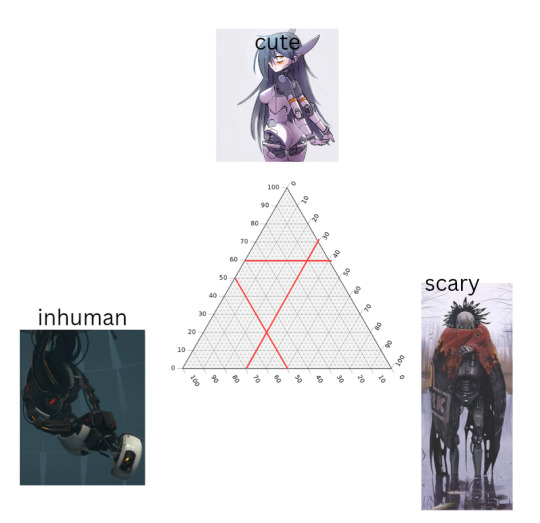
place yourself on my robotgirl transition goals not ternary graph. (uses 3 lines instead of 1 point as the 3 variables dont neccesarily add to 100)
blank copy below:
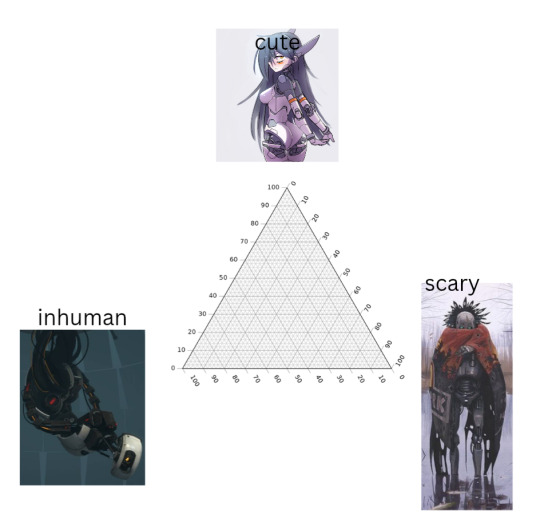
288 notes
·
View notes
Text
The theory of operation for my balanced ternary "shift register" is actually pretty simple, though it might not look like it -- once you spend some time in it, so to speak, it's totally grokable.
Ready? This is gonna be looong.
Okay.
First, in case anyone reading this is unaware of what a logic gate, truth table, or the balanced ternary number system is, you'll want to read these three Wikipedia articles to get some background knowledge:
https://en.wikipedia.org/wiki/Truth_table
https://en.wikipedia.org/wiki/Logic_gate
https://en.wikipedia.org/wiki/Balanced_ternary
Second, if you're unaware of how water and lava behave in Minecraft, you'll want to read this article from the Minecraft wiki.
Thirdly, you'll want to read these excerpts (↓) from my notes (my apologies for their quality), where I list my personal conventions and definitions for what is to come.
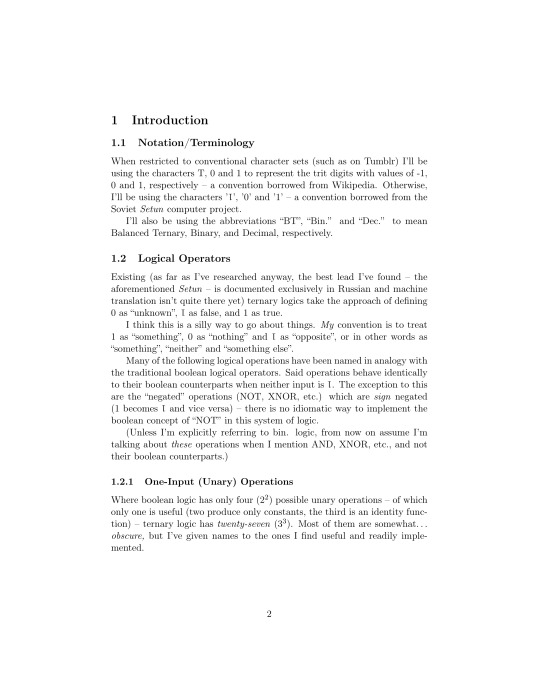
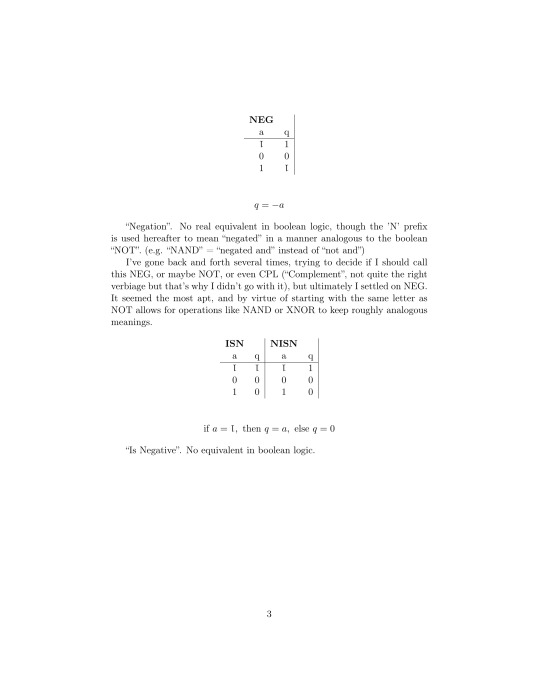
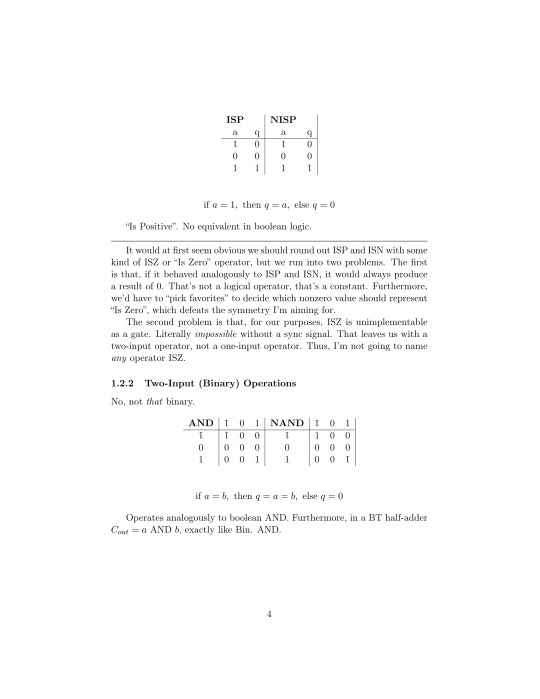

Got that all?
What we want to do now is try to construct some of the aforementioned logic gates with Minecraft's fluid model. Water will be used to represent 1, lava will represent T (-1), and air (neither water nor lava) will represent 0.
Believe it or not, this isn't too difficult. Most of the logic gates I describe above are rather simple to implement -- so long as we ignore the timing constraints imparted by water and lava flowing at different rates, which for the sake of brevity (brevity, lol) we will.
Two of the most fundamental of these logic gates, at least for our purposes, are MAND and OR. They are implemented like this (↓)
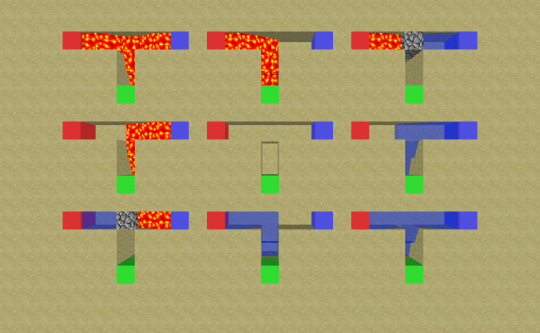

If you're having trouble grasping how these work, and have access to a copy of the game, I encourage you to play around with it yourself! After a while, the principles start to become pretty intuitive.
We can use these "fundamental" gates to construct the rest. ISN, ISP, NISN, and NISP can be made by simply hard-wiring one or the other of the inputs of a MAND gate to 1/water or T/lava. (Not that you'd always want to implement ISP in particular that way--it's actually the third fundamental logic gate and can be implemented via a different principle, but I digress)
From there we can construct NEG, as NEG a is equal to (NISN a) OR (NISP a); from NEG we can construct AND, because a AND b = a MAND (NEG b); and so on and so forth. (Exercise for the reader to derive the rest :P)
This brings us back to the shift register, which is primarily constructed of these (↓) little circuits who operate analogously to normally-closed relays.
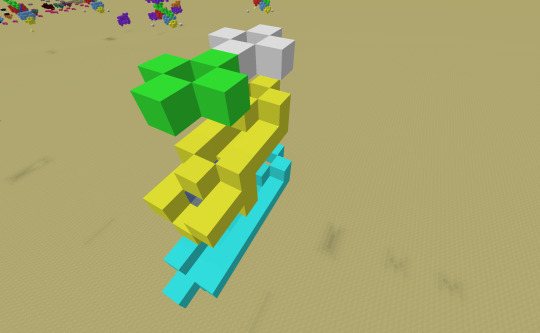
Let the green input be a, the white input be b, and the output be q. When a is nonnegative (0 or 1), b will "pass through", so to speak, and q = b. When a is negative (T), q will always be 0.
Put more simply, q = b OR (ISN a) OR (NISN a). Run the numbers and you'll see how it works!
From there, it's pretty trivial to line a few of these up, tie their outputs together, and get a demultiplexer -- a circuit that takes in some number of inputs (here three) and "selects" one of them to output. Let's look at our demultiplexer now:

Let s1, s2 and s3 be the blue "selector" inputs; p1, p2, and p3 be the white "selectee" inputs; b1, b2 and b3 be the intermediate "blocking" signals (the green inputs from earlier); q1, q2 and q3 be the outputs from our relays; and q (no number) be the overall output.
The yellow and light blue circuitry are our relays, the black concrete is the aforementioned output tying-together (q = q1 OR q2 Or q3), and the blue and red circuitry is... complicated.
Its job, though, is simple: translate a positive "selecting" signal on one of its three inputs (s1, s2 and s3) into two negative "blocking" signals to be sent to the relays (b1, b2, b3).
This is implemented as follows:
b1 = (NISP (s1 OR s2 OR s3)) OR s1 b2 = (NISP (s1 OR s2 OR s3)) OR s2 b3 = (NISP (s1 OR s2 OR s3)) OR s3
In other words, b1 is negative iff s2 or s3 is positive, b2 is negative iff s1 or s3 is positive, and b3 is negative iff s1 or s2 is positive.
Let's work through an example. Say c1 is 1, c2 is 0 and c3 is T, and we set s3 to 1--"selecting" c3.
Since s1 and s2 are 0, and s3 is 1, s1 OR s2 OR s3 = 1 and NISP (s1 OR s2 OR s3) = T
It follows then that b1 = T OR s1 = T OR 0 = T, b2 = T OR s2 = T OR 0 = T, and b3 = T OR s3 = T OR 1 = 0.
Finally, since b1 and b2 are T, q1 and q2 are 0 (relay 1 and relay 2 "block" their inputs from flowing through) and since b3 is 0, q3 = p3 and thus q = q3 = p3 = T.
Got that? Great! Let's move on to the monster then.

A diagram may be in order.
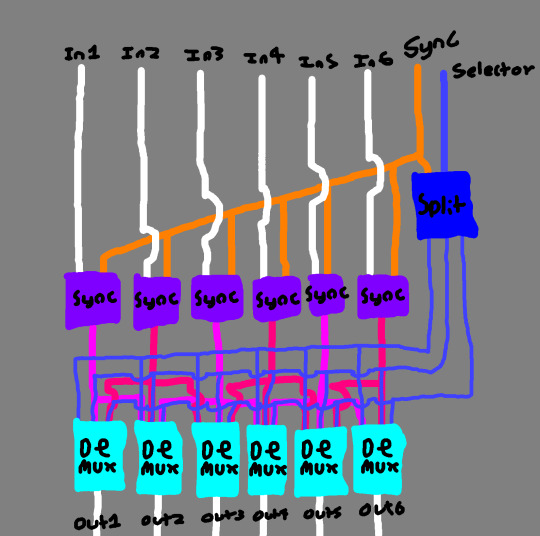
Better?
The shift register (again not the correct term because this is a one-time use circuit, but I digress -- they're roughly analogous) is constructed mainly of demultiplexers (light blue boxes), as described before.
Each demuxer is selecting between the input directly above it, the input to its left, and the input to its right. (e.g. demuxer #4 is selecting between In3, In4 and In5).
The signals telling the demuxers which inputs to select (s1, s2 and s3 from earlier) are generated by the "split" box (in blue) from the "Selector" signal. If "Selector" is T, "Split" sends a positive signal to the s1 input of the demuxers; if it is 0, s2; if it is 1, s3.
This is implemented as follows:
s1 = NISN "Selector" s2 = NISN ("Sync" OR s1 OR s3) s3 = ISP "Selector"
The "Sync" signal line (in orange) and circuits (purple boxes) work to ensure the timing constraints and invariants we've so far elided are upheld. "Sync" is always either 0 (wait for sync) or T (resume), never 1.
The purple boxes work like the opposite of the relays we described earlier: they receive an input and only output it after they receive a "Sync" signal.
They are implemented as follows:
q = (a MAND "Sync") OR (a MAND (NISN "Sync"))
Likewise, the "Split" box waits for a "Sync" signal to determine if "Selector" is 0 -- if it "jumped the gun" it wouldn't be able to go back and correct its output, all fluid-based logic gates are necessarily one time use.
What does all of this nonsense accomplish?
When "Selector" is 0, the input is simply passed through; when "Selector" is T, the input is shifted left (Out1 = In2, Out2 = In3... Out6 = 0); when "Selector" is 1, the input is shifted right (Out1 = 0, Out2 = In1... Out6 = In5). This is equivalent to either multiplying or dividing the output by 3.
And that's that!
If you have any further questions, feel free to let me know! Hell, if you managed to read this whole thing, feel free to let me know! (I hope at least someone is able to...)
48 notes
·
View notes
Text
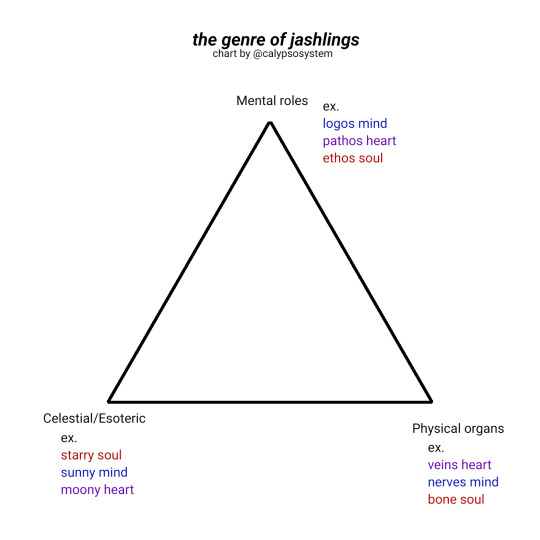
tag your jashlings and place them somewhere in this chart (which I just learned is a ternary plot)
#chonny jash#chonnys charming chaos compendium#cccc#chonny jash heart#chonny jash mind#chonny jash soul#chart#get your little freaks in the scale#i want to see how everyone rates their own hms#ternary plot
50 notes
·
View notes
Note
1!11001000!010 (balanced ternary, base three where ! represents negative one)
1!11001000!010 factorizes as 10×1!11001000!01
#prime factors#semi prime#3#433747#asks#i've never worked with balanced ternary before#that was fun lol
5 notes
·
View notes
Text

January 20th 2025
Inauguration Day

Donald Trump takes the oath of office as the 47th president of the United States.
#never forget#January 20th 2025#life liberty and the pursuit of happiness#freedom from ternary#make america great again 🇺🇸#Inauguration day#swearing-in ceremony
4 notes
·
View notes
Text

gdscript is fun
#godot#been messin around makin a lil game project#and discovered the ternary operator is transgender#game dev
44 notes
·
View notes
Photo

Ternary Tower in Shanghai, China
Istanbul-based Hayri Atak Architectural Design Studio (HAADS) revealed rendered images for Ternary Tower, an undulating three-piece tower in Shanghai, China. The project, which consists of 3 separate blocks, has a height of 400 meters. When the three separate pieces come together, they remind each other of the pieces that complement each other and reveal a smooth transitional image in the city silhouette.




#ternary tower#shanghai#china#future architecture#architecture#istanbul-based#hayri atak architectural design studio (haads)#cityscape
23 notes
·
View notes
Photo

Eight of Pentacles. Art by Suzanne Treister, from HEXEN 2.0.
Soviet Ternary Computers
15 notes
·
View notes
Text
Midtrinary Pride Flag

Midtrinary or midternary: non-trinary identities that are not strictly atrinary/exotrinary (aternary/exoternary); an umbrella term for midbinary, midtertiary genders, and other labels referencing gender trinary/aptoternary/aptotrinary.
Examples: demitrinary (but not necessarily demiatrinary as the other part can be anontrinary/anonternary)/viatrinary/ideotrinary [demiternary/viaternary/ideoternary], multigender experiences involving at least one trinary gender (multrinary/multitrinary), trinaryflux, etc.
This term was not defined yet, but used in an illustrative infographic from gender juxtaposition diagrams.
It should be noted that trinaries could depend on one's cultural arities, as the tertiary trinary gender could be a culturally specific identity ("third gender") or could just be neutral (neutrois/agender). Sometimes trinary/nontrinary doesn't apply to the individual either, for example when one's gender is from a quinary or senary system.
#mod .ap#midtrinary#mid-trinary#pride flag#pride-flags#mogai#nontrinary#alitrinary#viatrinary#ideotrinary#mesotrinary#multrinary#multitrinary#third gender#nonbinary#non-trinary#mesoternary#aliternary#mid-ternary
21 notes
·
View notes


